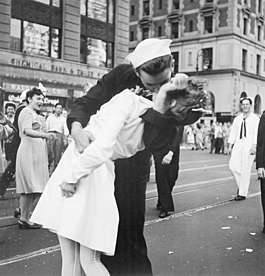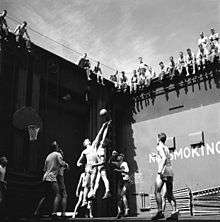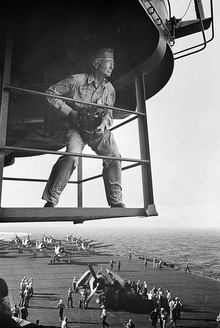Victor Jorgensen
Victor Jorgensen (July 8, 1913 – June 14, 1994) was a former Navy photo journalist who probably is most notable for taking an instantly iconic photograph of an impromptu scene in Manhattan on August 14, 1945, but from a different angle and in a less dramatic exposure than that of a photograph taken by Alfred Eisenstaedt. Both photographs were of the same V-J Day embrace of a woman in a white dress by a sailor. Eisenstaedt's better known photograph, V-J Day in Times Square, was published in Life.
Victor Jorgensen | |
|---|---|
._-_NARA_-_520839.jpg) Lt. Victor Jorgensen relaxing in his quarters aboard the USS Lexington, ca. 1943 | |
| Born | Victor Hugo Jorgensen July 8, 1913 |
| Died | June 14, 1994 (aged 80) |
| Occupation | photo journalist |
| Known for | taking photograph of nurse Greta Zimmer Friedman being kissed by Navy Sailor George Mendonsa on August 14, 1945 published in The New York Times |
On the day after the images were taken by the two photographers, the one taken by Jorgensen was published in The New York Times.[1] His photograph, which was taken while he was on duty, is retained in the National Archives and Records Administration.
Biography



Jorgensen was born in Portland, Oregon. He attended the University of Oregon and Reed College, graduating in 1936.[2] He married Betty Price on June 17, 1935.[3]
After college, he joined the staff of The Oregonian, working his way up from copy boy to night city editor. During his time at the newspaper, he became interested in photography and by the advent of World War II he was becoming a respected photographer.[3]
In 1942, Jorgensen enlisted in the Navy and was one of six initial photographers recruited by Edward Steichen to join the Naval Aviation Photographic Unit during the war.[4] He served aboard aircraft carriers USS Lexington in the Gilbert Islands (fall 1943); the USS Monterey in the Mariana Islands (1944); destroyer USS Albert W. Grant and shore duty in Borneo and the Philippines during Douglas MacArthur's return in 1944; and the hospital ship USS Solace off Okinawa, spring 1945.[3]
While aboard the USS Monterey, he captured Navy pilots in the forward elevator well of the ship playing basketball during June 1944. One of the subjects, the jumper of the left, is Gerald Ford, who later became the president of the United States upon the resignation of Richard Nixon.[6]
On V J Day, 1945, both Jorgensen and Eisenstaedt captured the image of a U.S. sailor grabbing a nurse for an impromptu kiss in the midst of Times Square celebrations. In a 2010 article, The New York Times described it as "a defining image of the American century, one that expressed the joy of a nation at its moment of greatest triumph."[7]
In the post-war decade, Jorgensen and his wife traveled the world as a photographer researcher team, contributing to magazines including Fortune, Saturday Evening Post, Collier's, Life, and Ladies Home Journal. Jorgensen served as president of the American Society of Media Photographers, working to establish minimum pay scales and fair practices for the photography industry.
Later life
After he left the Navy, Jorgensen settled in Maryland. He took over Chesapeake Skipper magazine, renaming it The Skipper and boosted its subscriptions from 1,500 to 50,000 by 1968. He and his wife moved to Portland at that time and started a boaters' consumer report newsletter. Jorgensen died of cancer in 1994 and was survived by his wife; two daughters; and two sisters.[2]
References
| Wikimedia Commons has media related to Victor Jorgensen. |
- Marshall Berman (March–April 2007). "COLUMBIA FORUM: Everyman in Times Square". —. COLUMBIA FORUM. Archived from the original on 2007-08-29. Retrieved 2007-09-24.CS1 maint: extra punctuation (link)
- "Victor Jorgensen '36". Reed Magazine. August 1994.
- "Victor H. Jorgensen Papers". The Regents of the University of California. Retrieved 6 April 2015.
- Faces of War: The Untold Story of Edward Steichen's WWII Photographers, pg. 48, Mark D. Faram, Berkeley Caliber, New York, New York, 2009, ISBN 978-0-425-22140-2
- "World War II Photographs". Military Units. 2007. Archived from the original on 2007-09-18. Retrieved 2007-09-09.
WW2042 "Activities aboard USS MONTEREY. Navy pilots in the forward elevator well playing basketball." Jumper at left identified as Gerald R. Ford. Attributed to Lt. Victor Jorgensen, circa June/July 1944.
- Newman, Andy (August 13, 2010). "Nurse Tells of Storied Kiss. No, Not That Nurse." The New York Times. Retrieved 6 April 2015.